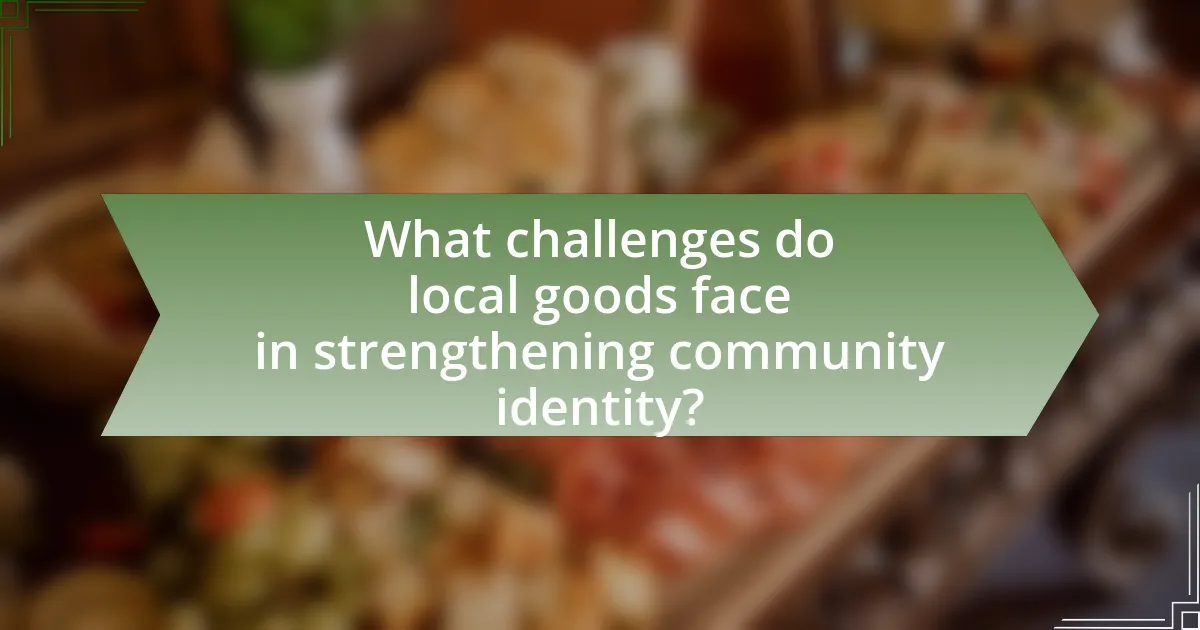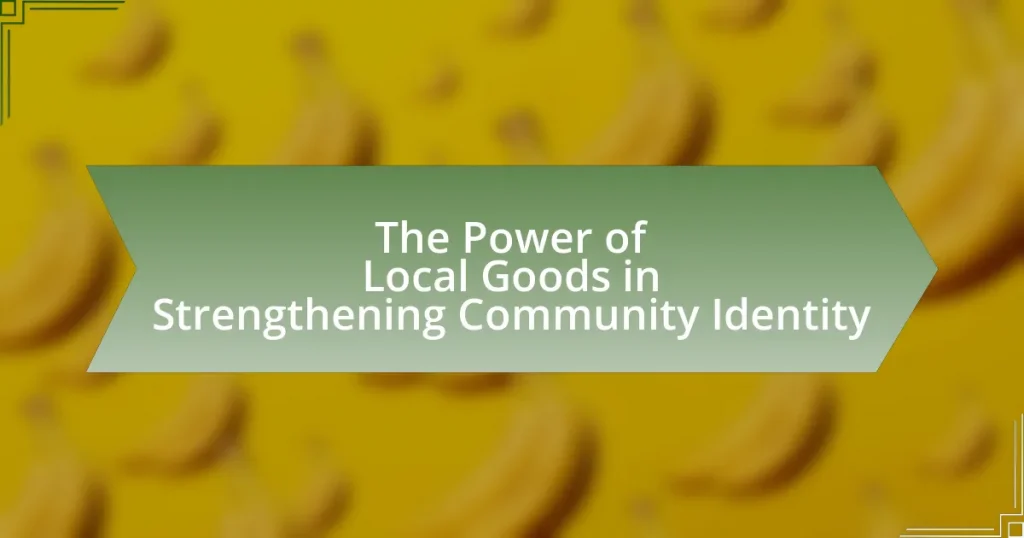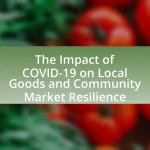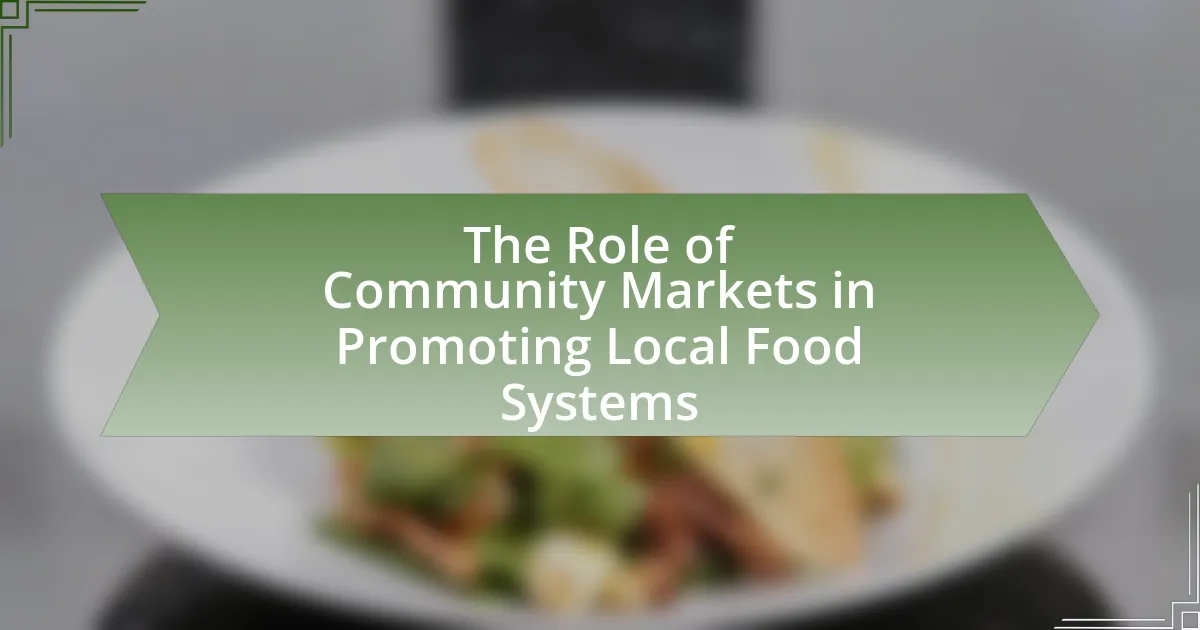The article examines the significant role of local goods in strengthening community identity. It highlights how local products, such as handmade crafts and regionally sourced food, foster a sense of belonging and cultural heritage while supporting local economies. The discussion includes the impact of local goods on social interactions, community pride, and economic sustainability, as well as the challenges they face from globalization and mass production. Strategies for promoting local goods and enhancing community engagement are also explored, emphasizing the importance of individual support for local businesses in reinforcing community ties.

What is the role of local goods in community identity?
Local goods play a crucial role in shaping community identity by fostering a sense of belonging and cultural heritage. They serve as tangible representations of local traditions, values, and history, which help to create a unique community character. For instance, products like locally sourced food, handmade crafts, and regional art not only support local economies but also reinforce social ties among residents. Studies have shown that communities with strong local goods markets often exhibit higher levels of civic engagement and pride, as these goods reflect the distinctiveness of the area and its people.
How do local goods contribute to a sense of belonging?
Local goods contribute to a sense of belonging by fostering community connections and cultural identity. When individuals purchase and consume products made locally, they engage with their community’s heritage and support local economies, which enhances social ties. Research indicates that communities with strong local goods markets experience increased social cohesion, as these markets serve as gathering places where residents interact and share experiences. For example, a study by the American Planning Association found that local farmers’ markets not only provide fresh produce but also create a space for community engagement, thereby reinforcing local identity and belonging.
What specific characteristics of local goods foster community ties?
Local goods foster community ties through their unique characteristics, such as cultural relevance, support for local economies, and the promotion of social interactions. Cultural relevance ensures that local goods reflect the traditions, values, and identities of the community, creating a sense of belonging among residents. Supporting local economies strengthens community ties by keeping financial resources within the area, which can lead to job creation and economic stability. Additionally, local goods often encourage social interactions, as markets and local shops serve as gathering places where community members can connect, share experiences, and build relationships. These characteristics collectively enhance community cohesion and identity.
How do local goods reflect the cultural heritage of a community?
Local goods reflect the cultural heritage of a community by embodying traditional practices, local resources, and historical narratives unique to that area. These goods often utilize indigenous materials and techniques, showcasing craftsmanship that has been passed down through generations. For example, handmade pottery in a specific region may incorporate local clay and traditional glazing methods, representing the community’s artistic heritage and connection to the land. Additionally, local foods, such as regional specialties, highlight agricultural practices and culinary traditions that are integral to the community’s identity. This connection to local goods fosters a sense of pride and belonging among residents, reinforcing cultural continuity and community cohesion.
Why are local goods important for economic sustainability?
Local goods are important for economic sustainability because they stimulate local economies by keeping money within the community. When consumers purchase local products, they support local businesses, which in turn creates jobs and fosters economic growth. According to a study by the American Independent Business Alliance, local businesses recirculate a greater share of every dollar as they create locally owned supply chains and invest in their employees. This results in a multiplier effect, where local spending generates additional economic activity, enhancing community resilience and reducing reliance on external markets.
What impact do local goods have on local economies?
Local goods significantly boost local economies by increasing job creation and retaining wealth within the community. When consumers purchase local products, a larger portion of their spending circulates within the area, supporting local businesses and services. According to a study by the American Independent Business Alliance, local businesses recirculate approximately 3.5 times more money in the local economy compared to chain stores. This recirculation leads to enhanced economic resilience, as local businesses are more likely to hire local employees and source materials from nearby suppliers, further strengthening the economic fabric of the community.
How do local goods support small businesses and artisans?
Local goods support small businesses and artisans by fostering economic resilience and promoting community engagement. When consumers purchase local products, they directly contribute to the financial stability of small enterprises, which often reinvest profits back into the local economy. According to a study by the American Independent Business Alliance, local businesses recirculate approximately 3.5 times more money in the local economy compared to chain stores. This increased economic activity not only sustains jobs but also enhances the unique cultural identity of the community, as artisans often create products that reflect local traditions and values. Thus, supporting local goods is integral to the vitality of small businesses and artisans, reinforcing both economic and cultural dimensions within the community.

How do local goods influence social interactions within communities?
Local goods enhance social interactions within communities by fostering connections among residents and promoting a sense of belonging. When individuals purchase and share local products, they engage in conversations and activities that strengthen community ties. For instance, farmers’ markets not only provide fresh produce but also serve as social hubs where people meet, exchange ideas, and build relationships. Research indicates that communities with strong local goods markets experience increased social cohesion, as evidenced by a study from the University of California, which found that local food initiatives significantly improve neighborhood social networks and trust among residents.
What role do local markets play in community engagement?
Local markets serve as vital hubs for community engagement by fostering social interactions and promoting local culture. They provide a space where residents can connect, share experiences, and support local businesses, thereby enhancing community cohesion. Research indicates that local markets can increase social capital, as they encourage participation in community activities and events. For instance, a study by the American Planning Association found that vibrant local markets contribute to a sense of belonging and identity among residents, reinforcing community ties and encouraging civic involvement.
How do local goods facilitate connections among residents?
Local goods facilitate connections among residents by fostering a sense of community and shared identity. When residents purchase and consume products made locally, they support their neighbors and local businesses, which creates economic interdependence. This interdependence encourages social interactions, as people engage in conversations about the goods, share recommendations, and participate in local markets or events. Research shows that communities with strong local goods networks experience increased social cohesion, as evidenced by a study published in the Journal of Community Development, which found that local purchasing leads to higher levels of trust and collaboration among residents.
What events or activities promote local goods and community interaction?
Farmers’ markets, craft fairs, and local festivals promote local goods and community interaction. These events provide a platform for local producers to showcase their products, fostering direct connections between consumers and creators. For instance, farmers’ markets often feature local agricultural products, allowing community members to support local farmers while engaging in social interactions. According to the USDA, farmers’ markets have increased by 76% from 2008 to 2019, highlighting their growing role in community engagement and local economies. Additionally, craft fairs and local festivals celebrate regional artisans and cultural heritage, further enhancing community ties and encouraging the purchase of locally made goods.
How do local goods enhance community pride and identity?
Local goods enhance community pride and identity by fostering a sense of belonging and connection among residents. When community members purchase and support local products, they contribute to the local economy, which in turn strengthens social ties and encourages collaboration. Research indicates that communities with strong local goods markets often report higher levels of civic engagement and satisfaction, as seen in studies conducted by the American Independent Business Alliance, which found that local businesses recirculate a greater share of every dollar as they create locally owned supply chains and invest in their employees. This economic impact reinforces community identity, as residents take pride in supporting their neighbors and celebrating local culture through unique products that reflect their heritage and values.
What are the psychological effects of supporting local goods?
Supporting local goods fosters a sense of community belonging and enhances individual well-being. When consumers choose local products, they often experience increased feelings of pride and connection to their community, which can lead to improved mental health outcomes. Research indicates that engaging with local economies can enhance social ties and promote a sense of identity, as individuals feel they are contributing to the welfare of their neighbors and local businesses. A study published in the Journal of Consumer Research found that consumers who support local businesses report higher levels of happiness and satisfaction, attributing this to the perceived positive impact of their purchases on the community.
How do local goods contribute to a unique community brand?
Local goods contribute to a unique community brand by fostering a sense of identity and belonging among residents. These products often reflect the culture, traditions, and values of the community, creating a distinct image that differentiates it from others. For instance, a study by the American Independent Business Alliance found that local businesses contribute to community identity by promoting local culture and heritage, which enhances the community’s brand. Additionally, local goods often utilize regional materials and craftsmanship, reinforcing the authenticity and uniqueness of the community’s offerings. This connection between local goods and community identity not only strengthens local pride but also encourages economic resilience by keeping resources within the community.

What challenges do local goods face in strengthening community identity?
Local goods face several challenges in strengthening community identity, primarily due to competition from mass-produced products, lack of awareness, and limited distribution channels. The prevalence of global brands often overshadows local offerings, making it difficult for community goods to gain visibility and consumer preference. Additionally, many consumers may not recognize the cultural significance or unique value of local goods, leading to a lack of support. Research indicates that local goods can enhance community identity, but without effective marketing and community engagement, their impact remains limited. For instance, a study by the American Independent Business Alliance found that local businesses recirculate a greater share of every dollar as compared to chain stores, yet many communities struggle to promote this message effectively.
How do globalization and mass production affect local goods?
Globalization and mass production negatively impact local goods by increasing competition and reducing their market share. As multinational corporations dominate the market with cheaper, mass-produced items, local artisans and producers struggle to compete on price and scale. For instance, a study by the International Labour Organization in 2019 highlighted that local businesses in developing countries often face significant challenges due to the influx of imported goods, leading to a decline in local craftsmanship and cultural heritage. This shift not only threatens the economic viability of local producers but also diminishes community identity, as unique local products become overshadowed by standardized global offerings.
What strategies can communities use to promote local goods?
Communities can promote local goods by implementing strategies such as organizing farmers’ markets, creating local business directories, and launching social media campaigns. Farmers’ markets provide a direct platform for local producers to sell their goods, fostering community engagement and supporting local economies. Local business directories help residents easily find and support nearby businesses, enhancing visibility for local products. Social media campaigns can effectively raise awareness and encourage residents to choose local options, as evidenced by studies showing that community-focused marketing increases local spending by up to 30%. These strategies collectively strengthen community identity by fostering connections between residents and local producers.
How can communities overcome barriers to supporting local goods?
Communities can overcome barriers to supporting local goods by fostering awareness and education about the benefits of local products. Initiatives such as workshops, farmers’ markets, and local business fairs can inform residents about the economic, environmental, and social advantages of purchasing locally. For instance, studies show that spending on local goods can keep three times more money in the local economy compared to spending at national chains. Additionally, communities can create incentives for local businesses, such as tax breaks or grants, to encourage their growth and sustainability. By building strong networks among local producers, consumers, and organizations, communities can enhance collaboration and create a supportive ecosystem for local goods.
What are the best practices for promoting local goods?
The best practices for promoting local goods include leveraging community engagement, utilizing social media marketing, and collaborating with local businesses. Community engagement fosters a sense of belonging and encourages residents to support local products, as evidenced by studies showing that local initiatives can increase consumer loyalty by up to 60%. Social media marketing allows for targeted outreach, enabling local producers to connect directly with consumers, which has been shown to enhance brand visibility and sales. Collaborating with local businesses creates a network effect, where shared resources and joint promotions can amplify reach and impact, leading to a 20% increase in local sales according to market research.
How can communities effectively market local goods to residents?
Communities can effectively market local goods to residents by leveraging local events, social media, and partnerships with local businesses. Organizing farmers’ markets, craft fairs, and community festivals allows residents to engage directly with local producers, fostering a sense of community and encouraging purchases. Utilizing social media platforms to showcase local products and share stories about their origins can enhance visibility and appeal. Collaborating with local businesses for cross-promotions can also amplify reach, as studies show that community-based marketing strategies increase consumer trust and loyalty, ultimately driving sales of local goods.
What role do social media and technology play in supporting local goods?
Social media and technology significantly enhance the visibility and accessibility of local goods. Platforms like Instagram and Facebook allow local businesses to showcase their products to a broader audience, facilitating direct engagement with consumers. According to a 2021 survey by the National Retail Federation, 70% of consumers reported discovering new local brands through social media. Additionally, e-commerce technologies enable local businesses to sell online, reaching customers beyond their immediate geographic area. This digital presence not only drives sales but also fosters community connections, as consumers increasingly value supporting local economies.
How can individuals contribute to the strength of local goods in their community?
Individuals can contribute to the strength of local goods in their community by actively supporting local businesses and purchasing locally produced items. This behavior not only boosts the local economy but also fosters a sense of community identity and pride. Research indicates that when consumers choose local products, approximately 68% of their spending stays within the community, compared to only 43% for non-local purchases. By prioritizing local goods, individuals help create jobs, sustain local artisans, and promote unique cultural offerings, thereby reinforcing the community’s economic and social fabric.




